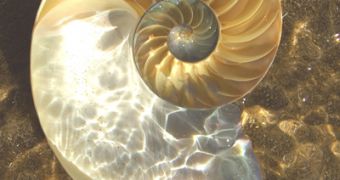We all know that the Earth's day is made of roughly 24 hours (there is an error of few seconds, corrected in the leap year) and it is due to the Earth's rotation movement around its own axis, that exposes different longitudes to the sunlight during this cycle.
But some old fossils came with a very puzzling data, suggesting an amazing hypothesis: once, the Earth day could have lasted just 10 hours!
This idea was suggested by a living fossil: a marine mollusk called Nautilus. Nautilus is the most primitive living cephalopod (related distantly to cuttlefish, squid and octopuses). Its close relatives are extinct, most of them even before the emergence of the dinosaurs.
As a sign of its primitiveness, it has a well-developed and functional shell. The spiraled shell is compartmented and bisymmetrical (a left part similar to the right, unlike the case of the snails, other shelled mollusks). The shell forms a perfect logarithmic spiral, a volute in which a chain of chambers is inserted: starting from the center the minute ones and finishing with a large funnel where the animal itself lives.
Today, there are just 6 species of Nautilus surviving in the western Pacific, retired at depths of 400 m and climbing to the surface just during the night.
Once, these animals were spread over all oceans and in all environments. There is a small groove on the inner part of the Nautilus shell and this structure marks the monthly growth rate of the Nautilus. The current shells of Nautilus have 29-30 stripes (like growth rings in trees), explained by the synodic month, equivalent to the 29.52 terrestrial days of a month.
This is a clear sign of the Moon's action on a terrestrial organism. But when the researchers checked fossil shells of Nautiloid mollusks, the 30 million years old ones had 25 monthly stripes, those 70 million years old 22 stripes and the 150-300 million years old ones just 17 stripes (this is exactly during the expansion of life on Earth).
Shells 300-400 million years old displayed just 9 stripes. This triggered a vivid debate amongst researchers: 400 million years ago, a terrestrial month was three times shorter.
Astronomical measurements show that 400 million years ago, the Moon was located at just 150,000 km (90,000 mi) from Earth (now it is at 384, 403 km or 238,857 mi) and the Earth was rotating around itself much faster, probably in 10 hours.
The power of the tides decreased in time the rotating energy of the Earth, transferred to the Moon, and allowed the Moon to constantly go further from the Earth, as the data recorded on the Nautilus's relatives show. Of course, as these mollusks recorded the Moon position just till 500 million years ago, where could the Moon have been located 4.4 billion years ago, when Earth appeared?
One hypothesis claims that there were no fossils 800 million years ago because Moon was so close to the Earth that the terrestrial crust was continuously remodeled, through the effect of the extremely powerful tides...

 14 DAY TRIAL //
14 DAY TRIAL // 

